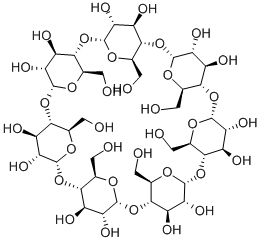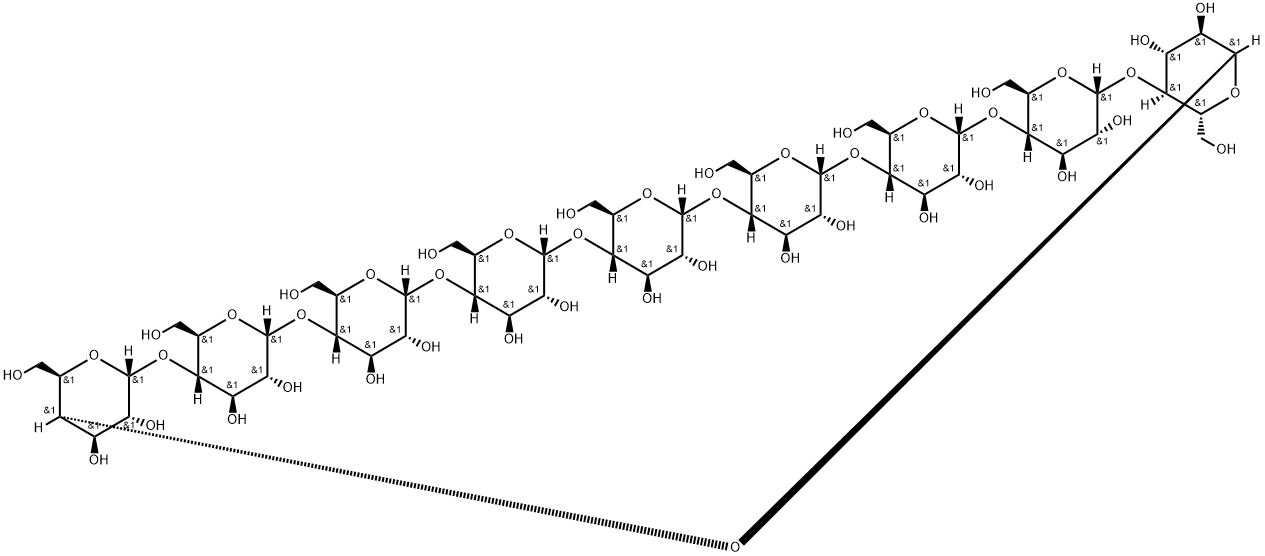beta-Cyclodextrin hydrate
Synonym(s):β-Schardinger dextrin;beta-Cyclodextrin hydrate;Cycloheptaamylose;Schardinger β-Dextrin hydrate
- CAS NO.:68168-23-0
- Empirical Formula: C42H70O35
- Molecular Weight: 1134.98
- MDL number: MFCD00150811
- EINECS: 231-493-2
- SAFETY DATA SHEET (SDS)
- Update Date: 2025-01-27 09:38:02

What is beta-Cyclodextrin hydrate?
Description
β-Cyclodextrin (β-CD) is a cyclic oligosaccharide that contains seven D-(+)-glucopyranose units and has been used to improve the aqueous solubility of various compounds, especially those containing a phenyl group. The circular arrangement of its glucose units produces a torus-shaped ring configuration in which the CH2 groups and ether linkages of the molecule face the hollow interior, resulting in a nonpolar, hydrophobic cavity and a polar, hydrophilic exterior. When combined in solution with other compounds, the nonpolar aromatic portions of that compound interact with the nonpolar interior of the β-CD molecule, thus isolating the aromatic portion of the molecule from the water and thereby increasing its aqueous solubility.
Chemical properties
white crystalline powder
The Uses of beta-Cyclodextrin hydrate
beta-Cyclodextrin hydrate forms clathrates. Produces a water-soluble complex with dansyl chloride for the fluorescent labeling of proteins. It is used in pharmaceutical research, as pharmaceutical intermediates and also as chemical reagents.
General Description
β-cyclodextrin (β-CD), a well-known macrocyclic oligosaccharide member of the CD family, is composed of seven D-glucose units connected via α(1→4) glycosidic bonds. Its ability to form several inclusion complexes with organic as well as inorganic compounds makes it a potential candidate in solid and solution state determinations.
Purification Methods
Recrystallise β-cyclodextrin from water and dry it for 12hours in a vacuum at 110o, or 24hours in a vacuum at 70o. The purity is assessed by TLC on cellulose containing a fluorescent indicator. [Taguchi, J Am Chem Soc 108 2705 1986, Tabushi et al. J Am Chem Soc 108 4514 1986, Orstam & Ross J Phys Chem 91 2739 1987.] [Beilstein 19 IV 6287, 19/12 V 801.]
Properties of beta-Cyclodextrin hydrate
| Melting point: | >260 °C (dec.)(lit.) |
| alpha | 161 º (c=1, H2O 25 ºC) |
| storage temp. | Refrigerator |
| solubility | Water (Slightly) |
| form | Crystalline Powder |
| color | White |
| optical activity | [α]20/D +142°, c = 1 in H2O (Dry basis) |
| Water Solubility | 18.5 g/L (25 ºC) |
| Merck | 14,2718 |
| BRN | 5915513 |
Safety information for beta-Cyclodextrin hydrate
Computed Descriptors for beta-Cyclodextrin hydrate
beta-Cyclodextrin hydrate manufacturer
JSK Chemicals
New Products
Methyl (R)-1-Boc-4,4-difluoropyrrolidine-2-carboxylate 2,2-Difluoropropylamine hydrochloride tert-butyl 3-bromoazetidine-1-carboxylate (R)-1-Boc-3-hydroxypyrrolidine DIFLUOROACETIC ANHYDRIDE 2,2-Difluoropropionic acid Diallylamine, 99% Calcium hydroxide, 95% Aluminum oxide, basic 2-Bromophenylacetonitrile, 97% L-tert-Leucine,97% N-Hydroxy-2-methylpropanimidamide 4-(3,4-Dichlorophenyl)-3,4-Dihydro-N-Methyl-1-(2H)-Naphthalenimine (Schiff Base) 2-AMINO-3,5-DIBROMO BENZALDEHYDE [ADBA] L-Glutamic Acid Dimethyl Ester Hcl 10-Methoxy-5H-dibenz[b,f]azepine 5-Cyanophthalide N, N-Carbonyldiimidazole (CDI) Dibenzoyl Peroxide Titanium Dioxide 2-(Methylthio) Benzonitrile Sodium Acetate Anhydrous Allopurinol 1,5-DibromopentaneRelated products of tetrahydrofuran








You may like
-
 Beta-Cyclodextrin hydrate, 98% 99%View Details
Beta-Cyclodextrin hydrate, 98% 99%View Details
68168-23-0 -
 Beta-Cyclodextrin hydrate CAS 68168-23-0View Details
Beta-Cyclodextrin hydrate CAS 68168-23-0View Details
68168-23-0 -
 β-Cyclodextrin hydrate CAS 68168-23-0View Details
β-Cyclodextrin hydrate CAS 68168-23-0View Details
68168-23-0 -
 Ethyl-2-Chloroacetoacetate 609-15-4View Details
Ethyl-2-Chloroacetoacetate 609-15-4View Details
609-15-4 -
 CIS- BROMO BENZOATEView Details
CIS- BROMO BENZOATEView Details
61397-56-6 -
 609-15-4View Details
609-15-4View Details
609-15-4 -
![1-(6-Methylpyridin-3-Yl)-2-[4-(Methylsulfonyl)Phenyl]Ethanone [Ketosulfone] 99%](https://img.chemicalbook.in//Content/image/CP5.jpg) 1-(6-Methylpyridin-3-Yl)-2-[4-(Methylsulfonyl)Phenyl]Ethanone [Ketosulfone] 99%View Details
1-(6-Methylpyridin-3-Yl)-2-[4-(Methylsulfonyl)Phenyl]Ethanone [Ketosulfone] 99%View Details
221615-75-4 -
 27143-07-3View Details
27143-07-3View Details
27143-07-3
